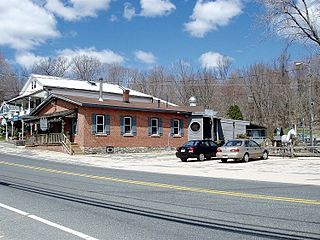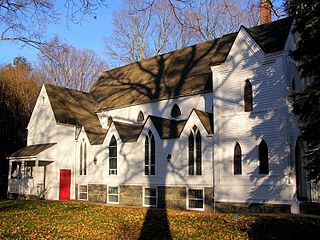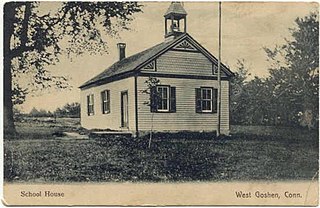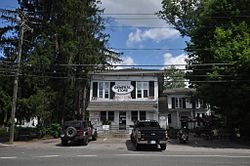
Collinsville is a village and census-designated place (CDP) in the town of Canton, Hartford County, Connecticut, United States. The population was 3,746 at the 2010 census. The central portion of the village is a historic district listed on the National Register of Historic Places.

Barkhamsted is a town in Litchfield County, Connecticut, United States. It contains seven villages, West Hill, Mallory, Barkhamsted Center, Center Hill, Washington Hill, Pleasant Valley, and Riverton. The population was 3,799 at the 2010 census, up from 3,494 at the 2000 census. The town incorporated in 1779. Barkhamsted was named after Berkhamsted, Hertfordshire, England.

Barkhamsted Hollow was a village in northwestern Connecticut. It was part of the town of Barkhamsted, Connecticut in Litchfield County, Connecticut, incorporated as part of Barkhamsted in 1779. It was flooded by the creation of the Barkhamsted Reservoir in 1940, splitting Barkhamsted and the nearby town of Hartland, Connecticut in half.

The Farmington River is a river, 46.7 miles (75.2 km) in length along its main stem, located in northwest Connecticut with major tributaries extending into southwest Massachusetts. The longest route of the river, from the origin of its West Branch, is 80.4 miles (129.4 km) long, making it the Connecticut River's longest tributary by 2.3 miles (3.7 km) over the major river directly to its north, the Westfield River. The Farmington River's watershed covers 609 square miles (1,580 km2). Historically, the river played an important role in small-scale manufacturing in towns along its course, but it is now mainly used for recreation and drinking water.

Lambert Hitchcock was an American furniture manufacturer, famous for designing and mass-producing the Hitchcock chair.

Route 181 is a rural state highway in northern Connecticut, running from Barkhamsted to Hartland.

The South Coventry Historic District is a historic district encompassing the historic village center of South Coventry in the town of Coventry, Connecticut. The village, settled in the early 18th century, has served as Coventry's civic center, and also served as an economic center, with textile mills operating in the 19th century. The district was listed on the National Register of Historic Places in 1991.

The Pine Meadow Historic District encompasses most of the historic 19th-century village of Pine Meadow in New Hartford, Connecticut. Located at a bend in the West Branch of the Farmington River southeast of New Hartford center, it is a well-preserved example of a rural industrial village. The district was listed on the National Register of Historic Places in 1996.

The West Goshen Historic District is a historic district in the village of West Goshen in the town of Goshen, Connecticut. It encompasses a well-preserved early 19th-century industrial village, with twenty historically significant properties in the village, most of which lie on Connecticut Route 4 between Beach Street and Thompson Road. The district was listed on the National Register of Historic Places in 1987.

The Milton Center Historic District encompasses the historic 19th-century village center of Milton in the northwestern part of the town of Litchfield, Connecticut. Basically linear, it stretches from Milton Cemetery in the west to the junction of Milton and Shearshop Roads in the east, including houses, churches, schools, and the remains of industrial sites. The district was listed on the National Register of Historic Places in 1986.

The Union Church/St. Paul's Church is a historic church building at 3 Robertsville Road in the Riverton section of Barkhamsted, Connecticut. Built in 1829 to be shared by multiple congregations, it is an architecturally distinguished example of Greek Revival design with Gothic features. It became an Episcopal church in 1880 which closed in 1971, and served for a time as a local history museum. It now houses a glass-blowing studio. The building was listed on the National Register of Historic Places in 1985.

Saville Dam is an earthen embankment dam with masonry work on the eastern branch of the Farmington River in southwestern Barkhamsted, Connecticut. The dam is 135 ft. tall and 1,950 ft. long and has an uncontrolled spillway on its western portion. It creates the Barkhamsted Reservoir which has a volume of 36.8 billion US gallons (139,000,000 m3) and is the primary water source for Hartford, Connecticut.

Quinnipiac River Historic District is a 313-acre (127 ha) historic district straddling the Quinnipiac River in the Fair Haven and Fair Haven Heights neighborhoods of New Haven, Connecticut. It encompasses most of the historic maritime village of Fair Haven, with a history dating back to the 18th century. It was listed on the National Register of Historic Places in 1984. At that time it included 524 contributing buildings, an inland wetland at the mouth of Hemingway Creek on the northeast corner of the district, and the Grand Avenue Swing Bridge over the Quinnipiac River connecting Fair Haven with Fair Haven Heights at the center of the district.

The Pequabuck Bridge is a historic stone arch bridge, carrying a paved multiuse trail across the Pequabuck River in Farmington, Connecticut. Built in 1833, the bridge formerly carried the adjacent Meadow Road. It is one of the state's only surviving early 19th-century stone arch bridges and was listed on the National Register of Historic Places in 1984.

Barkhamsted Center Historic District is a historic district at the intersection of Center Hill Road and Old Town Hall Road in Barkhamsted, Connecticut. It encompasses the surviving elements of Barkhamsted's original town center, most of which was flooded by the creation of Barkhamsted Reservoir in the early 20th century. The district was listed on the National Register of Historic Places in 1999.

The Barkhamsted Lighthouse was a historical community located in what is now Peoples State Forest in Barkhamsted, Connecticut. Set on a terrace above the eastern bank of the West Branch Farmington River, it was in the 18th and 19th centuries a small village of economically marginalized mixed Native American, African American, and white residents. It was given the name "lighthouse" because its lights acted as a beacon marking the north-south stage road that paralleled the river. The archaeological remains of the village site were listed on the National Register of Historic Places in 1991 as Lighthouse Archeological Site (5-37).

The William Moore Jr. House is a historic house at 5 Mountain Road in the Riverton village of Barkhamsted, Connecticut. Built about 1820, it is a good local example of Federal period architecture in brick, and is notable for its association with the Moore family, where both the father and son were involved in the early chair-making trade for which Riverton is well known. The house was listed on the National Register of Historic Places in 1999.

The Old Riverton Inn is a historic hotel and tavern at 436 East River Road in the Riverton village of Barkhamsted, Connecticut. Built in 1811, it has been in continuous operation as a traveler's accommodation since then. It was listed on the National Register of Historic Places in 1992.

The Palisado Avenue Historic District encompasses a predominantly residential streetscape in northeastern Windsor, Connecticut. Extending along Palisado Avenue between the Farmington River and Bissell Ferry Road, it is a basically 18th-century street view, populated mainly with houses from the 18th to the 20th centuries. The district was listed on the National Register of Historic Places in 1987.

The Pines Bridge Historic District encompasses a historic industrial and commercial village in North Haven, Connecticut. Located just west of the town green and centered around the Broadway bridge over the Quinnipiac River, the village developed first as a commercial hub around a 17th-century bridge at the site, and then as a small industrial village in the 19th century. Now mainly residential, it was listed on the National Register of Historic Places in 1988.























